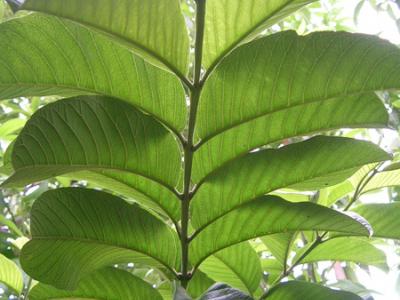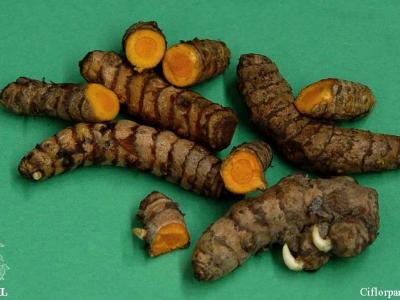(dans les territoires avec usage significatif TRAMIL)
Cuba:
- anón
Martinique:
- pomm kannel
Antigua-et-Barbuda:
- sugar apple
feuille, décoction, voie orale1
Selon l’information disponible :
L'emploi contre la crise de foie ("mal fwa") est classé REC basé sur l'usage significatif traditionnel documenté par les enquêtes TRAMIL et les études de toxicité.
Si l'état du patient se détériore ou si la crise de foie persiste plus de 3 jours, consulter un médecin.
L'emploi contre les douleurs d'estomac, les gaz et le rhume est classé REC basé sur l'usage significatif traditionnel documenté par les enquêtes TRAMIL, les études de toxicité, de validation et l’information scientifique publiée disponible.
Si l'état du patient se détériore ou que la douleur d'estomac persiste plus de 3 jours, consulter un médecin.
En raison du risque de neurotoxicité dû à la présence de composés neurotoxiques présents dans la feuille de certaines espèces de la famille des annonacées et du lien établi avec l'apparition de parkinson atypique4, éviter la consommation prolongée (plus d'un an).
Ne pas employer avec des femmes enceintes, allaitantes, ni avec des enfants de moins de 12 ans.
Contre les douleurs d'estomac :
Préparer une décoction avec 30 grammes de jeunes feuilles dans 4 tasses (1 litre) d'eau, bouillir 5 minutes dans un récipient couvert. Laisser refroidir, filtrer et boire 1 tasse 3 à 4 fois par jour.
Contre gaz ou rhume :
Préparer une décoction avec 50 feuilles fraîches (10 grammes) ou 30 grammes de parties aériennes préalablement lavées, dans 4 tasses (1 litre) d'eau, bouillir 10 minutes dans un récipient couvert. Laisser refroidir, filtrer et boire 1 tasse 3 à 4 fois par jour.
Toute préparation médicinale doit être conservée au froid et utilisée dans les 24 heures.
1 LONGUEFOSSE JL, NOSSIN E, 1990-95
Enquête TRAMIL. Association pour la valorisation des plantes médicinales de la Caraïbe AVPMC, Fort de France, Martinique.
2 CARBALLO A, 1990
Encuesta TRAMIL. Centro de investigación de fitoterapia y medicina tradicional de Topes de Collantes, Trinidad, Cuba.
3 O'REILLY A, 1992
TRAMIL survey. Chemistry & Food Technology Division, Ministry of Agriculture, Dunbars, Antigua & Barbuda.
4 CAPARROS-LEFEBVRE D, 2003
Atypical parkinsonism in the tropics: from Pacific to the Caribbean and evaluation of isoquinoline derivatives toxicity. In: The 9th meeting of the International Neurotoxicology Association (INA-9) abstracts book. Dresden, Germany:p19.
5 MOREJÓN Z, VICTORIA MC, MOROÓN F, MÉNDEZ G, 2005
Tamizaje fitoquímico de la decocción de hoja fresca y extracto fluido de hoja seca de Annona squamosa L. Informe TRAMIL. Laboratorio Central de Farmacología, Facultad de Ciencias Médicas "Dr. Salvador Allende", La Habana, Cuba.
6 JOSHI HD, BAXI GA, BAXI AJ, 1992
Free amino acids and sugars of Annona squamosa Linn. Asian J Chem 4(1):49-52.
7 MOORE BD, ISIDORO E, SEEMANN JR, 1993
Distribution of 2-carboxyarabinitol among plants. Phytochemistry 34(3):703-707.
8 YADAV D, SINGH N, DEV K, SHARMA R, SAHAI M, PALIT G, MAURY R, 2011
Anti-ulcer constituents of Annona squamosa twigs. Fitoterapia 82(4):666-675.
9 SHARMA RK, BEHARI M, 1992
Screening of the compounds isolated from the leaves of Annona squamosa for antibacterial activity. Acta Cienc Indica Chem 18(3):249-252.
10 SHARMA RK, 1993
Phytosterols: wide-spectrum antibacterial agents. Bioorg Chem 21(1):49-60.
11 SHARMA RK, BEHARI M, 1992
Screening of the compounds isolated from the leaves of Annona squamosa for antibacterial activity. Acta Cienc Indica 27C(3):249-252.
12 YANG HJ, LI X, ZHANG N, CHEN JW, WANG MY, 2009
Two new cytotoxic acetogenins from Annona squamosa. J of Asian Natural Products Research 11(3):250–256.
13 JOHNS T, WINDUST A, JURGENS T, MANSOR SM, 2011
Antimalarial alkaloids isolated from Annona squamosa. Phytopharmacology 1(3):49-53.
14 VILA-NOVA NS, DE MORAIS SM, FALCÃO MJ, MACHADO LK, BEVILÁQUA CM, COSTA IR, DE SOUSA BRASIL NV, DE ANDRADE JÚNIOR HF, 2011
Leishmanicidal activity and cytotoxicity of compounds from two Annonacea species cultivated in Northeastern Brazil. Rev Soc Bras Med Trop 44(5):567-571.
15 WAGNER H, REITER M, FERSTL W, 1980
New drugs with cardiotonic activity. I. Chemistry and pharmacology of the cardiotonic active principle of Annona squasmosa L. Planta Med 40:77-85.
16 SEETHARAMAN TR, 1986
Flavonoids from the leaves of Annona squamosa and Polyalthia longifolia. Fitoterapia 57(3):198-199.
17 SONI H, SHARMA S, PATEL SS, MISHRA K, SINGHAI AK, 2011
Preliminary phytochemical screenig and HPLC analysis of flavonoids from methanolic extract of leaves of Annona squamosa. International Research J of Pharmacy 2(5):242-246.
18 BALBAA SI, HAGGAG MY, TAHA KF, 1977
Study of volatile oil content of the leaves of Annona squamosa growing in Egypt. Egypt J Pharm Sci 18:1-8.
19 RAI C, MUTHANA MS, 1954
Essential oil from the leaves of Annona squamosa. J Indian Inst Sci 36:117.
20 MARTÍNEZ I, MORÓN FJ, VICTORIA MdC, BRITO G, ACOSTA L, FUENTES V, 2011
Efecto antipirético oral de la decocción 30% de hojas frescas de Annona squamosa (anón) en ratas. Informe TRAMIL. Facultad de Ciencias Médicas “Dr. Salvador Allende”, Laboratorio Central de Farmacología, La Habana, Cuba.
21 VICTORIA MC, MORÓN F, MARTÍNEZ MC, PINEDO Z, BOUCOURT E, MOREJÓN Z, FUENTES V, 2006
Actividad analgésica de la decocción de hoja fresca de Annona squamosa L. en contorciones inducidas por ácido acético en ratones. Informe TRAMIL. Laboratorio Central de Farmacología, Facultad de Ciencias Médicas "Dr. Salvador Allende", La Habana, Cuba.
22 MORÓN F, VICTORIA MC, MARTÍNEZ MC, PINEDO Z, BOUCOURT E, MOREJÓN Z, FUENTES V, 2005
Actividad antiinflamatoria de la decocción de hoja fresca de Annona squamosa L. en ratas. Informe TRAMIL. Laboratorio Central de Farmacología, Facultad de Ciencias Médicas "Dr. Salvador Allende", La Habana, Cuba.
23 PUAPATANAKUL O, 1980
Clinical studies of Annona squamosa seeds and leaves for treatment of head lice. J Pharm Ass Thailand 34(2/3):91-105.
24 MOHAMED SALEEM TS, CHRISTINA AJM, CHIDAMBARANATHAN N, RAVI V, GAUTHAMAN K, 2008
Hepatoprotective activity of Annona squamosa Linn. on experimental animal model. Int J Applied Research in Natural Products 1(3):1-7.
25 PALANISAMY A, RAJESH V, PERUMAL P, VAMSI B, 2011
Anti ulcer activity of ethanolic extract of Annona squamosa leaves. Int J of Pharmaceutical Research and Development 4(1):162–167.
26 MARTÍNEZ MJ, MOREJÓN Z, LÓPEZ M, BOUCOURT E, BARCELO H, LAYNEZ A, FUENTES V, MORÓN F, 2003
Clases Tóxicas Agudas (CTA) de decocción cogollo fresco de Annona squamosa L. en ratas. Informe TRAMIL. Laboratorio Central de Farmacología, Facultad de Ciencias Médicas “Dr. Salvador Allende”, La Habana, Cuba.
27 MARTÍNEZ MJ, MOREJÓN Z, LÓPEZ M, BOUCOURT E, BARCELO H, LAYNEZ A, FUENTES V, MORÓN F, 2003
Clases Tóxicas Agudas (CTA) de decocción de hoja fresca de Annona squamosa L. en ratas. Informe TRAMIL. Laboratorio Central de Farmacología, Facultad de Ciencias Médicas “Dr. Salvador Allende”, La Habana, Cuba.
28 MARTÍNEZ MJ, MOREJÓN Z, LÓPEZ M, BOUCOURT E, BARCELO H, LAYNEZ A, FUENTES V, MORÓN F, 2003
Clases Tóxicas Agudas (CTA) de decocción de partes aéreas secas de Annona squamosa L. en ratas. Laboratorio Central de Farmacología, Facultad de Medicina “Dr. Salvador Allende”, Informe TRAMIL. La Habana, Cuba.
29 MARTÍNEZ MJ, MOREJÓN Z, LÓPEZ M, BOUCOURT E, FUENTES V, MORÓN F, 2005
Clases tóxicas agudas (CTA) de extracto fluido de hoja seca de Annona squamosa L. en ratas. Informe TRAMIL. Laboratorio Central de Farmacología, Facultad de Ciencias Médicas “Dr. Salvador Allende”, La Habana, Cuba.
30 BARROS GSG, MATOS FJA, VIEIRA JEV, SOUSA MP, MEDEIROS MC, 1970
Pharmacological screening of some Brazilian plants. J Pharm Pharmacol 22:116.
31 MISHRA MB, TEWARI JP, MISHRA SS, 1966
Studies in indigenous uterotonic drugs (a preliminary note). Indian J Physiol Pharmacol 10:59.
32 SHIRWAIKAR A, RAJENDRAN K, DINESH KUMAR C, BODLA R, 2004
Antidiabetic activity of aqueous leaf extract of Annona squamosa in streptozotocin–nicotinamide type 2 diabetic rats. J Ethnopharmacol 91(1):171-175.
33 BHAKUNI OS, DHAR ML, DHAR MM, DHAWAN BN, MEHROTRA BN, 1969
Screening of Indian plants for biological activity. Part II. Indian J Exp Biol 7:250-262.
34 CAPARROS-LEFEBVRE D, ELBAZ A, 1999
Possible relation of atypical parkinsonism in the French West Indies with consumption of tropical plants: a case-control study. Lancet 354(9175):281-286.



